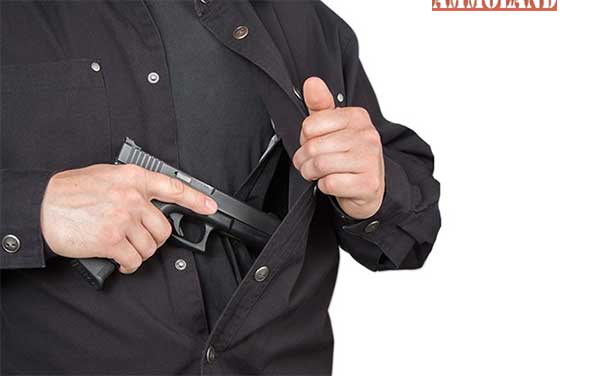

USA -(AmmoLand.com)- Concealed Carry Dry Fire
Dry fire is where you can practice the absolute fundamentals of firing a handgun. Dry fire allows a shooter to practice everything in the fundamentals, including breath control and finding your natural respiratory pause. You can practice your sight picture, and getting correct sight alignment. Most importantly you can practice grip and trigger control. Dry fire is something anyone can do, and is free.
While it’s cool and fun to practice moving and shooting, defensive drills, and drawing your firearm, dry fire can be somewhat boring. Even though it can be boring it’s still one of the best (and cheapest) things you can do to learn the proper fundamentals of shooting. The best time to do dry fire practice is after a range trip, like immediately after. Your body and mind are still hot from live fire and can accurately diagnose mistakes. [be sure and use Snap Caps to avoid damage to your firearm.]
Concealed Carry Drawing / Reholstering
Fights, especially ones where guns are drawn often end very, very fast are when you end up in a defensive situation where you need your firearm. One should practice drawing your firearm, and learning and knowing your weapon and holster. Always start slow and take your time. A fast draw is good, but you also need a sure draw, a draw you can do when your heart is pumping, and you begin to lose fine motor skills. When you begin to practice drawing you should do it with a dry weapon, meaning unloaded. Once you gain a solid understanding of how to safely draw a weapon, then you move onto doing it live.
Reholstering is something you want to practice doing in a safe and slow manner. When you put your weapon away there is no need to rush it. If you are holstering your weapon then the fight is over.
Concealed Carry Malfunction drills
Modern firearms are quite unlikely to malfunction, as long as it’s from a reputable manufacturer. Because of this we rarely ever get a chance to deal with an actual malfunction. A malfunction is probably the worst thing to happen in a gunfight, but you can recover from it if you train for it.
Train with snap caps, which are dummy ammunition that simulates the weight, length and width of a cartridge. Load your magazines randomly with a snap cap amongst live ammo. This will induce a malfunction never predicted. Clearing malfunctions should be a well-versed part of anyone’s training.
Concealed Carry Multiple Positions
We want to take all of the above training techniques, dry firing, drawing, and malfunction drills and change it up a bit. We want to practice dry firing from the knee, and then practice drawing and dry firing from a knee behind cover, and then practice drawing, dry firing from a knee behind cover and then clearing a malfunction. Being able to draw, dry fire and clear a malfunction from any body position is a critical skill to have. This means doing it from your back, from behind cover, from a low standing, or any other assortment of positions.
Concealed Carry Situational Awareness
This is something we should practice at any given time, a skill we should develop at all times minus when you’re sleeping. Situational awareness is something that some instinctively have, and others have to work at.
You should scan your environment, making eye contact with people, and genuinely be aware of what’s around you. Know where entrances and exits are. Know where your body’s position is in relation to entrances and exits. Take note of suspicious people and try to stay away from them.
Stay in touch with us to get your concealed carry information and gun safety classes!
National Carry Academy:
National Carry Academy is the nation’s premier training resource for those that decide to carry a gun as a part of their lifestyle.
For more information, visit: www.nationalcarryacademy.com.
